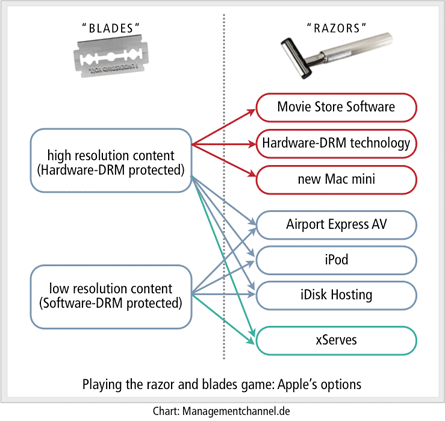Apple’s movie store strategy: Exploring blades and razors
We do not know if the latest rumor about Apple preparing a massive overhaul to its movie store and digital distribution system is true, but that’s not hindering us from hypothesizing about Apple’s business options in this market.
When Apple started their online music business with the iTunes Music Store, its iTMS business model was said to turn the razor and blades business model on its head by selling the songs (i.e. the blades) at a subsidized price and making the profit on high margin iPods (i.e. the razors).
To explore Apple’s options in the online movie market we will follow this familiar razor and blade scheme and discuss
1. Will the blades be given away again?
2. What will the razor be this time?
The competitive environment in the movie download business is – in some respects – very similar to that of the music download business when Apple entered it in 2003. Back then Apple faced a powerful competitor, illegal file swapping networks, who “offered” music for free. But Apple managed to compete with piracy by setting a reasonable price and building its easy-to-use iTunes Music Store.
Likewise the movie download business today faces stiff competition from Television (which is free and easy-to-use), from pay-TV (which is reasonably priced and offers exclusive content) and video rental stores (which offer favorable and ad-free content).
Thus it seems obvious, that the path to success can’t be taken through premium pricing. In order to convince customers of regularly using the new service, Apple has to make a compelling offer in terms of price, size of content catalog and user experience.
But if the answer to question number one is “yes” and Apple is going to offer movies and TV shows at a low price point, where would Apple’s margin come from? Or to paraphrase: What kind of high margin razor are they going to sell to us?
If you think that’s an easy question and the answer is the rumored new Mac mini equipped with an Intel processor and hardware-based DRM technology, because the content owners demand the Mac mini’s new hardware-based digital rights management to protect their content, think twice. With no new Mac minis out there in the wild: how long would it take to build a sufficient customer base for the new movie store? At least too long to make it appear as a clever strategic decision.
But if the copy protection scheme is bound to the introduction of new hardware and if the content owners insist upon a rigid protection of their precious artwork, are there any other options at all?
As we argued elsewhere, Apple’s new video distribution system will be all about leveraging the iTunes Music Store’s customer base. To accomplish this, Apple could sell TWO kinds of blades: On the one hand hardware-DRM-protected high definition content, on the other hand software-DRM-protected low resolution content (Quicktime’s H.264 codec provides the necessary technology to do so).
Every current iTunes Music Store customer could immediately begin to download movies using the low-res option and this would open plenty of options for Apple to sell suitable razors:
- To enhance the viewing experience, it would be nice to watch the shows on the TV in the living room. This could be done by purchasing an iPod with video-capabilities (razor #1) or a yet-to-be introduced Airport Express with video streaming capabilities (razor #2).
- To know the true promise of Apple’s movie store one would be tempted to buy the new Mac mini (razor #3). By the way, we should consider the new Mac mini less as a Mac with HD movie store capabilities (nobody wants to put a computer in the living room) than as a stationary iPod video on steroids with computer capabilities as an add-on (but sans screen).
- Furthermore Apple could charge the HD-store user for hosting the movies on the user’s personal server space (razor #4).
- As the content owners could urge Apple to open the HD store to customers, who don’t own a new Mac mini, but a PC based on Intel’s “Viiv” chip set, Apple could license its hardware-DRM related technology to the manufacturers of those Viiv-PCs (razor #5).
- Apple could decide to charge ordinary “Viiv”-PC customers for the HD version of its movie store software (razor #6), but include the software for free on its mac minis.
- Finally Quicktime’s growing ubiquity on user’s desktops would stimulate the adoption of Quicktime as the media format of choice for independent publishers and this would increase the demand for Apple’s xServes (razor #7).
Which option is Apple going to choose? Hey, this is not a rumor site!


